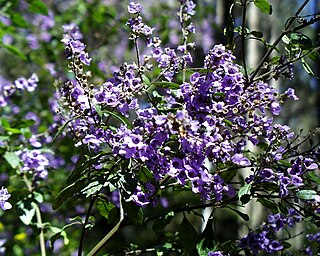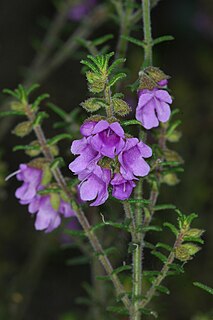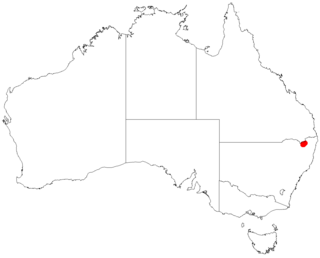
Prostanthera melissifolia, commonly known as balm mint bush, is a species of flowering plant in the family Lamiaceae and is endemic to south-eastern Australia. It is an erect shrub with hairy branches, egg-shaped leaves with fine teeth on the edges and mauve to purple or pink flowers on the ends of branchlets.

Prostanthera phylicifolia, commonly known as spiked mint-bush, is a species of plant in the family Lamiaceae. It is an erect shrub with four-ridged branches, narrow egg-shaped to oval leaves and white or pale lilac-coloured flowers with purple and yellow spots.

Prostanthera magnifica, commonly known as magnificent prostanthera, is a species of flowering plant in the family Lamiaceae and is endemic to Western Australia. It is a slender to spreading, erect shrub that has hairy stems, elliptical to narrow egg-shaped leaves and pale mauve or pale blue to pink flowers with prominent dark mauve to purple sepals.

Persoonia arborea, commonly known as tree geebung, is a species of large shrub or small tree that is endemic to Victoria, Australia.

Prostanthera walteri, commonly known as blotchy mint-bush, is a species of flowering plant that is endemic to south-eastern Australia. It is a sprawling shrub with tangled, hairy branches, egg-shaped leaves and usually bluish green flowers with prominent purple veins arranged singly in leaf axils.

Prostanthera decussata, commonly known as dense mintbush, species of flowering plant that is endemic south-eastern Australia. It is a dense, compact, strongly aromatic shrub with egg-shaped leaves and mauve to violet flowers with yellow streaks, arranged in leaf axils near the ends of branchlets.
Persoonia brachystylis is a species of flowering plant in the family Proteaceae and is endemic to a restricted area on the west coast of Western Australia. It is an erect, spreading shrub with smooth bark, narrow spatula-shaped to lance-shaped leaves and yellow flowers in groups of ten to twenty.

Prostanthera staurophylla, commonly known as Tenterfield mint-bush, is a species of flowering plant in the family Lamiaceae and is endemic to a small area on the New England Tableland of New South Wales. It is an erect to spreading, strongly aromatic shrub with hairy branches, deeply lobed leaves and bluish-mauve flowers with darker markings.

Prostanthera prostantheroides is a plant in the family Lamiaceae and is endemic to Western Australia. It is a shrub with heart-shaped to round leaves and usually white flowers with purple spots inside the petal tube.

Isopogon crithmifolius is a species of plant in the family Proteaceae and is endemic to the south-west of Western Australia. It is a shrub with divided leaves and more or less spherical heads of glabrous reddish pink flowers.

Bossiaea decumbens is a spreading, prostrate shrub in the pea family (Fabaceae), and is endemic to Victoria. It has alternate, variable shaped leaves and yellow pea flowers with red splotches from spring to late summer.

Rhadinothamnus euphemiae, is a slender, small, upright shrub with needle-shaped branchlets thickly covered with silvery scales and tubular greenish-purple tubular flowers throughout the year. It is endemic to the south coast of Western Australia.

Prostanthera behriana, commonly known as tall mintbush, is a species of flowering plant in the family Lamiaceae and is endemic to the south-east of South Australia. It is an erect to straggling shrub with egg-shaped leaves and white, pale blue, pale violet or purplish white flowers with red-brown spots or purple streaks inside.

Prostanthera eckersleyana, commonly known as crinkly mintbush, is a species of flowering plant in the family Lamiaceae and is endemic to the south-west of Western Australia. It is an erect or spreading shrub with sticky, hairy branchlets, egg-shaped to elliptical leaves and blue, mauve to purple or violet flowers with maroon spots inside the petal tube.

Prostanthera grylloana is a species of flowering plant in the family Lamiaceae and is endemic to Western Australia. It is a small, erect shrub with densely hairy branchlets, small, spatula-shaped leaves and red to pink flowers.

Prostanthera scutata is a species of flowering plant in the family Lamiaceae and is endemic to Western Australia. It is a small, erect, compact shrub with densely hairy branches, elliptic to narrow elliptic leaves and pale blue or faintly violet flowers.

Prostanthera wilkieana is a species of flowering plant that is endemic to the more arid areas of Australia. It is an erect, densely-branched shrub with elliptic to narrow egg-shaped leaves with the narrower end towards the base and mauve to pale violet or white flowers with deep purple streaks and yellowish brown dots inside the petal tube.
Elaeocarpus grahamii is a species of flowering plant in the family Elaeocarpaceae and is endemic to north-east Queensland. It is a small to medium-sized tree, sometimes coppicing, with elliptic to egg-shaped leaves, flowers with five petals that have a frilled tip, and oval blue fruit.
Elaeocarpus ruminatus, commonly known as brown quandong, caloon or grey quandong, is a species of flowering plant in the family Elaeocarpaceae and is endemic to Queensland. It is a tree with buttress roots at the base of the trunk, mostly more or less elliptic leaves, cream-coloured flowers with five petals that sometimes have a divided tip, and more or less spherical fruit.
Goodenia minutiflora is a species of flowering plant in the family Goodeniaceae and is endemic to northern Australia. It is an annual herb with linear to lance-shaped leaves, and loose groups of tiny white or purplish flowers.
















